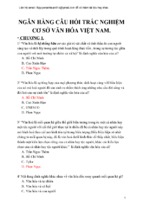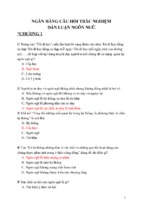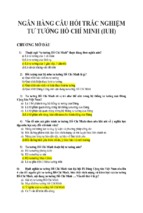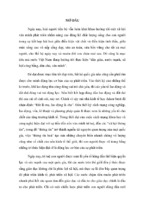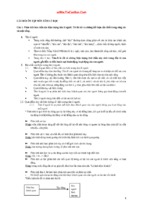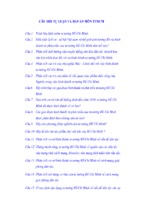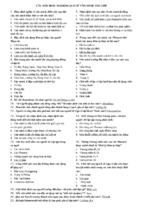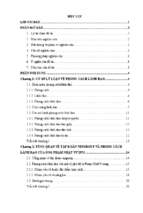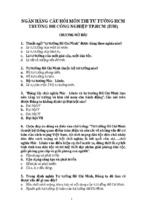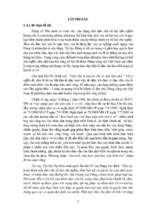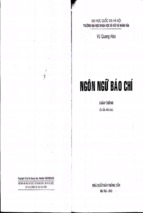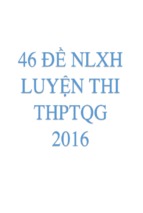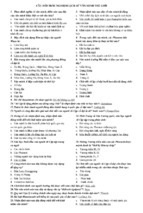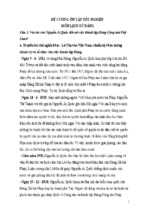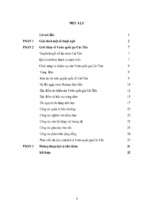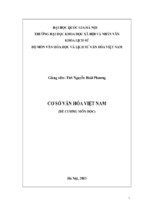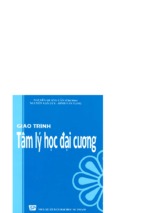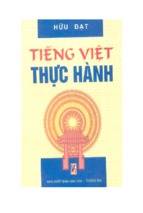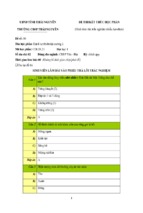1
PREFACE
1. Reason for choosing the topic
1.1. Developing mathematical thinking competence is one of the essential
requirements in teaching Mathematics at high school: Nowadays, education with oriented the
development of individual learners’ competence has been become an essential requirement.
Mathematical problem-solving competence and creative competence are defined as specific
competences that need to be created for students through mathematics teaching at high school.
In teaching, teachers could encourage learners how to discover and solve problems, how to
think and gain creative thinking, skill training, ability to solve problems of real life through
teaching knowledge. The author Tran Kieu also emphasized “the need to pay attention to the
capacity of logical thinking in inference, reasoning; at the same time attach to critical thinking,
creativity, as well as predictive facts, mathematical intuition and spatial imagination”.
Therefore, developing mathematical thinking competence for students is one of the
requirements that be recommonded in teaching Mathematics at high school.
1.2. Identify the role of intuition and the research issues on intuition: The problem on
intuition which has been studied extensively in the world, is concerned with its meaning, diverse
role and manifestations. Some authors claimed intuition as the source of innovation and is a
first and necessary step for education, such as the works of the authors: Wild (1938), Poincaré
(1958), Bunge (1962), Bruner (1965), Descartes and Spinoza (1967), Westcott (1968), DiSessa
(1982). Some researchers argued that intuition can be trained and applied in the education
process such as Tall and Vinner (1980), Fischbein (1987), Tieszen (1989), Jagla (1994),
Hogarth (2001), Giardino (2010), Young Hoan Cho and Seo Yon Hong (2015). Although there
are many studies on intuition and mathematical intuition in Vietnam about the concept in the
material on the development of mathematical thinking for students, no researches on the
application of mathematical intuition in mathematical teaching.
1.3. The reality of teaching Mathematics has focused on deductive inference and
formal reasoning, not interested in the development of mathematical intuitive competence:
In mathematics teaching at high school, when students face unfamiliar situations or new
problems, teachers often spend much time to provide students with procedural knowledge, most
of them have a slight opportunity for trying to think, discovering ways to solve problems. This
led to many students only learn the formal knowledge, mainly using without knowing use of
mathematical knowledge to solve problems in real life. On the other hand, in mathematics
teaching, most of the teacher's teaching methods and the presentation in the textbook content
with theorems, rules, and proofs are often presented as are available products. While intuition
plays a significant role in the process of developing students' perceptions and can help them
become more active and creative in making judgments, discovering new knowledge, finding
strategy of problem-solving and making decision by themselves before embarking on specific
manipulations. Therefore, if students have mathematical intuitive competence, it will help them
gain curious habits, such as exploring, thinking and finding ways to solve problems,
2
connections between visualization with abstract. It leads to them apply those ways in different
situations or in unfamiliar contexts. Thus, mathematical intuitive competence (MIC) is one of
the important competences that needs training for students to know how to grasp knowledge,
recognize problem solving strategies, toward to develop mathematical thinking. For these
reasons, we choose the topic “Developing mathematical intuitive competence for students in
teaching Mathematics at high school”.
2. Purposes of the study
Propose the procedure of organizing cognitive activities toward to develop students’
MIC and the ways of the developing each components through teaching Mathematics at high
school, so thereby contributing to improve the effectiveness of teaching Mathematics.
3. Research tasks: The thesis finds the answers for the following questions:
3.1. What is students’ MIC? What are the characteristics of students’ MIC? What are
the components of the MIC in learning mathematics? What opportunities are found to develop
students’ MIC through teaching Mathematics at high school?
3.2. How is current teaching situation of the development of the MIC for students at some
high school?
3.3. What are the steps in the procedure of organizing cognitive activities toward to
develop students’ MIC in teaching Mathematics at high school? How to organize cognitive
activities to develop each components of the MIC in teaching Mathematics at high school?
3.4. How to conduct to check the feasibility and appropriateness of the proposed
procedure during the pedagogy experiment?
4. Object and scope of the study
4.1. Object of the study: the teaching process toward to the developing students’
mathematical intuitive competence through teaching Mathematics at high school.
4.2. Scope of the study: the content of teaching in the mathematics program in grades
10 and 11 and the teaching process to acquire those mathematical contents at high school.
5. Scientific theories: If the thesis determines students’ characteristics of the MIC and
proposes the procedure toward to the organizing cognitive activities for students in accordance
with the teaching practice at high school, students would gain mathematical knowledge more
actively and creatively, and contribute to develop their MIC, so thereby meet the requirements of
innovation to improve of teaching Mathematics in oriented developing learners’ competence.
6. Research methods: Theoretical study method, observation - investigation method,
professional method, pedagogical experiment method and study - case method.
7. Contributions of the dissertation
7.1. In theory
- Clarifying the students’ characteristics of the MIC and the components of students’
MIC in teaching Mathematics at high school.
- Proposing the procedure of the organizing cognitive activities toward to develop
students’ MIC through teaching some mathematical contents at high school.
3
- Proposing the ways of the organizing cognitive activities toward to develop the
components of the MIC through teaching Mathematics at high school.
7.2. In practice
- Proposing the procedure for teacher to organize cognitive activities developing
students’ MIC through teaching Mathematics.
- Contributing to innovation of the mathematics teaching method toward to focusing on
developing the MIC for students.
8. Theses that were protected
- The characteristics and components of MIC in learning mathematics at high school.
- The procedure of the organizing cognitive activities toward to develop students’ MIC
in teaching Mathematics at high school.
- The ways of the organizing cognitive activities toward to develop the components’
MIC through teaching Mathematics at high school.
9. Structure of the dissertation
Chapter 1. Theoretical foundation
Chapter 2. Practical foundation
Chapter 3. Organizing cognitive activities toward to develop students’ MIC in
teaching Mathematics at high school
Chapter 4. Pedagogical experiment
CHAPTER 1
THEORETICAL FOUNDATION
1.1. An overview of relevant researchs
1.1.1. The researchs of intuition and mathematical intuition
1.1.1.1. Problem in intuition and mathematical intuition in the world
In the world, the problem of intuition has been studied through works in many fields:
philosophy, psychology, mathematics and education... Some intuitive theory in the field of
philosophy have representatives such as Kant, Hilbert and Bernays, Husserl, Godel, Parsons,
Brouwer, Bergson. In cognitive psychology, psychologists have devoted to studying the
process of insight into things, immediate understanding of things and experiences "aha" after
the time of solving problem failed. The conception of intuition by mathematicians such as
Poincaré, Descartes, Hadamard, Koliagin, Konmogrorop ... and in the field of education with
some writers’ work on using intuition and mathematical intuition in the teaching process such
as Tall and Vinner, Fischbein, Tieszen, Jagla, Hogarth, Giardino, Young Hoan Cho and Seo
Yon Hong.
1.1.1.2. Problem in intuition and mathematical intuition in domestic
In Vietnam, some authors also refer to the concept of intuition in the literature on the
development of mathematical thinking, mathematical competence such as Nguyen Van Loc,
Pham Gia Duc and Pham Duc Quang, Tran Luan, Nguyen Phu Loc.
4
1.1.1.3. Some observations from the results in mathematical intuition on domestic and
foreign: From the researches in the world, we find that the problems of mathematical intuition
are deeply studied with different aspects and has been widely used in many areas of
mathematics and Mathematical education. But the great roles and characteristics of
mathematical intuition in teaching Mathematics in Vietnam is still untapped and has no many
researches aimed to using in practice of teaching Mathematics at high school.
1.1.2. The researches of organizing mathematical cognitive activities
The researches on teaching some mathematical contents in high school towards
positively activating cognitive activities such as the doctoral thesis of the authors Pham Minh
Tien, Nguyen Manh Chung, Tran Trung; research on the process of organizing awareness
activities for students through Dao Tam’s works were also interested in teaching Mathematics.
However, there is no specific research materials on organization of cognitive activities in order
to develop the students’ MIC through teaching Mathematics at high school.
1.1.3. The receptive results
In short, the problem of developing students’ MIC in teaching Mathematics in Vietnam
has not been exploited, so we absorb the following results:
- Studying on the concept, factors related to the shape and development of the MIC.
- Studying the application of the MIC during the teaching process.
- Studying the process of organizing cognitive activities for students through teaching
Mathematics at high school.
From these results, we will study to propose the concept and clarify some
characteristics of the MIC, identify some components of the MIC towards building the process
of organizing cognitive activities for students to develop the MIC through teaching
Mathematics at high school.
1.2. Students’ mathematical intuitive competence in learning mathematics at high
school
1.2.1. Intuition, mathematical intuition
1.2.1.1. The concepts of intuition: Although there are many concepts in the different
mentioned categories, but most of the concepts have the following two characteristics:
“directly grasp knowledge quickly” and “do not require clear arguments”. In the process of
understanding and analyzing, we chose to approach the concept of intuition according to
“cognition”. Because, there is a very close relationship between awareness and thinking,
awareness is also associated with activities to be effective in solving problems that have a
positive impact on the process. The learners' awareness towards organizing the cognitive
activities to develop students’ capacity in the process of teaching in high school. Therefore,
we have acknowledged the approach of viewing intuition as human perception and carrying
the two above characteristics. Therefore, inheriting from the concept of author Piaget, we
claim “Intuition can be understood as the immediate and implicit cognition of objects without
analytical reasoning in the cognitive process”.
1.2.1.2. Classification of intuition
5
+ According to Fischbein, based on origins of intuitions: primary intuition and
secondary intuition. Based on roles, classification of intuitions may be grouped into
affirmatory intuitions, conjectual intuitions, anticipatory intuitions and conclusive intuitions.
+ According to Piaget, intuition insist on empirical intuitions and operational intuitions.
+ Bahm has mentioned three types of intuition: Objective intuitions, subjective intuitions
and organic intuitions.
+ According to Baylor, classification intuitions may be grouped immature intuition and
mature intuition.
1.2.1.2. Mathematical intuition: Mathematical intuition can be understood as the
immediate and implicit cognition of mathematical objects, relations, and facts which occurs the
reduction of analytical reasoning or without analytical reasoning in the cognitive process.
1.2.2. Intuitive thinking in teaching mathematics
According to author Koliagin, Intuitive thinking is one of the basic components of
mathematical thinking, in which “Intuitive thinking is a special method of awareness,
characterized by finding truth directly, related to the phenomena such as unexpected,
lightning-fast problem solving, non-compliance with logical requirements, results obtained
by this method very quickly”. Nguyen Van Loc said that “Mathematical intuition is an
element of a thinking method called Intuitive thinking, that is an type of thinking based on
the perception of the whole problem immediately, capable of performing in the form of
sudden change, shortened process of argument. Therefore, Intuitive thinking is characterized
by the absence of clear reasoning steps, this type of thinking is characterized by the perception
collapsing quickly, immediately and helping them to have direct conclusions about the
problem, completely bypassing the intermediary stage, is the leap forward thinking process,
the person with creative deposit immediately responds to the question, the ability to visualize
the outcome of an issue without absolutely a full process.
1.2.3. Students’ mathematical intuitive competence
1.2.3.1. Competence and students’ competence in learning mathematics:
Competence is a combination of unique attributes of an individual, including
knowledge, skills and attitudes, in accordance with the requirements of a given activity,
ensuring that the activity is effective.
Students’ competence in learning mathematics is the ability to mobilize their
knowledge, skills, experiences and attitudes such as the interest, belief, willing to effectively
implement activities in the process of learning mathematics.
1.2.3.2. Thinking competence, mathematical competence in learning mathematics
“Thinking competence is considered to be the level of applying intellectual activity, it
is very diverse in using information to achieve results. It includes factors such as problem
solving, making decisions, critical thinking, developing arguments and using evidence to
support their arguments. It also is the core of many intellectual activities”.
According to the author Krutexki, “mathematical competence is understood as
personal psychological characteristics (firstly the characteristics of intellectual activity) to
6
meet the requirements of mathematical learning activities, and in the same solid conditions,
it is the cause of the success in mastering mathematically creatively as a subject, especially
mastering the knowledge and skills quickly, easily and deeply in the mathematical field”.
1.2.3.3. Students’ mathematical intuitive competence in learning mathematics
We understand that “Students’ mathematical intuitive competence is the thinking
capacity who apply intellectual activities to realize the internal characteristics and attributes
of mathematical objects, relationships and problems quickly in specific cognitive situations
in the process of learning mathematics, on the basis of students performing the reduction of
reasoning or without analytical reasoning in the cognitive process”.
Students’ MIC is related to thinking skills such as association, imagination, judgment
and generalization. It is considered as a combination of many mathematical thinking
competencies, and is the result of the intellectual activity process smoothly without relying
on clear explanations or strict sequences of deductive process. Moreover, it also depends on
the process of accumulating knowledge, experience and skills system along with attitudes,
emotions and qualities of each individual learner. When facing the same problem, for this
student, the possibility of generalized learning can occur quickly but other students must take
place more slowly. Therefore, in teaching Mathematics, teachers should focus on training
mathematical thinking skills to create a foundation for them.
a) Deduction and imagination: According to Nguyen Van Loc, “In geometric study,
geometric intuition is understood as imaginary competence such as imaging shapes and their
transformations”. MIC is represented by imaginary abilities such as imaging shapes and
properties, seeing changes, relationships between objects, it is also the ability to visualize the
way of the solving problem, force see the result of the problem. In mathematics, mathematical
intuition is expressed in the ability to visualize the transformations of mental expressions by
shortening some of the transformational steps without fully realizing it. It is possible to
visualize the mathematical knowledge that is being considered with the actual model or the
ability to visualize the problem solving approach before proceeding.
b) Association: Association plays a special role in the process of developing knowledge
cognition as well as the process of developing students' thinking. Without the ability to associate
and mobilize knowledge, there is no intuition, so it will be poor in ideas and ability to solve
problems is also limited. However, to associate and to mobilize knowledge effectively as well as to
have a valuable intuitive basis, there must be reflexive association. Furthermore, learners must have
the capacity to associate quickly and precisely to facilitate effective intuition. The building this
capacity contributes to developing, expanding knowledge and fostering exploration to discover new
knowledge for students on the basis of previous experience.
c) Judgement and generalization: Mathematical intuition is the direct realization of the
mathematical object and relationship in the process of cognition without the need for detailed
steps and justification, perceiver can make judgments on mathematical object and relations
through thinking abilities such as generalization, inductive inference without the need for
7
rigorous sequencing of the inference process, in some cases, a student can give predictions
about the nature, predicting the outcome of the problem
1.2.4. The roles of mathematical intuition in teaching Mathematics
Intuition plays a decisive role not only in the realization of discoveries but also in
scientific activity and in education. Wilder mentioned “Intuition plays a basic and
indispensable role in mathematical research and in modern teaching methods”, to provide a
conceptual foundation that suggests the directions. Burton said “The research mathematicians
provided clear directions towards a mathematical pedagogy that could be as engaging, exciting
and rewarding for learners, as it was for them in their own practices. These directions were firstly
towards valuing and nurturing intuitions and also recognising the importance of making
connections or links in the building of mathematical meaning”. In our opinion, the role of
mathematical intuition for modern approachs in mathematics education is as follows: using
mathematical intuition as a way for making predictions or judgments, scientific hypotheses for
the detection of mathematical problem, guiding the way of mathematical problem solving and
clarifying the meaning of mathematical knowledge.
1.2.5. Some students’ characteristics of mathematical intuitive competence in
teaching Mathematics at high school
1.2.5.1. Characteristic 1: Characterized by the immediately direct cognition of
mathematical objects, relations and problems: MIC is characterized by direct perception of
mathematical objects, relationships and problems, which help students perceive quickly and
immediately the intrinsic properties of mathematical objects, relationships and problems in the
process of learning knowledge. Mathematical intuition as the glow in the problem solving
process, so students’ mathematical intuition competence expressed that they can grasp and deal
with problems or see the results of problems immediately.
1.2.5.2. Characteristic 2: Characterized by a shortened process of argument or without
using the full logic steps: MIC is the capacity which the perceiver in the aware process of
mathematical object and relations without the need for rigorous sequencing of the inference
process, in some cases seeing the result of the problem that can not be explained. The MIC’s
rapid cognition of the mathematical object, relationship and problems is due to intermediate steps
in the process of reasoning, interpretation and analysis have been reduced and shortened.
1.2.5.3. Characteristic 3: Characterized by the ability to activate associations and
mobilize knowledge flexibly through the process of accumulation, reflection in observation,
previous problem solving: The other characteristic of students’ MIC is the product of the
process of accumulation, reflection in observation, research and problem solving, with the
flexibility of knowledge, the speed of association. It demonstrates at the higher level of
cognition such as the rise of cognitive processes and the deepening of intellectual thinking.
1.2.5.4. Characteristic 4: Characterized by creativity, breakthrough in making ideas
and strategies to solve the problem: MIC is characterized by some features of creative
thinking with the flashing of breakthrough and new ideas when learners face in unfamiliar
8
situations. As mathematical intuition is demonstrated a flexible thinking and the speed of
activation of associations, so students can quickly divert from this thinking to other when
problems solving process is ineffective. It expresses high modulus when they attempt to solve
the problem flexibly in new context.
1.2.6. The components of students’ mathematical intuitive competence in teaching
Mathematics at high school
1.2.6.1. Competence of the association and imagination problem: Competence of
association and imagination problem is the operational capacity of the students to link and
imagine mathematical objects and relationships with each other in specific cognitive
situations from which to mobilize relevant knowledge so that the students can solve the
mathematical problems. Training this competence may contribute to developing, expanding
knowledge and fostering exploration methods for students on the basis of existing knowledge.
Thus, the new is formed through the transform of associations and the speed of activation of
associations. Practicing activities to transform the associations between the objects for
students have the effect of developing thinking competence to help students appear intuitive
ideas and discover new knowledge.
1.2.6.2. Competence of the immediate generalization: Mathematical intuition is the
direct cognition of mathematical elements and objects, look like sudden flashes, which may be
the result of the movement of generalized modes and reduced structures. According to V. A.
Krutexki “In many cases, the sudden flash of a student's ability can be explained by the
unconscious influence of past experience, which basis is the ability to generalize mathematical
objects, relationships and calculations and thinking competence with reduced structures”.
Mathematical intuition is the immediate cognition of mathematical objects, relations and
problems due to the reduction of the analytical steps in learners’ awareness process. Therefore,
to want to develop the students’ MIC, the teacher need to train them to be able to generalize for
realizing the nature or the solution of a problem immediately.
1.2.6.3. Competence of the judgement and decision making: Competence of judgement
and decision making is the operational capacity of the students to make assumptions about
mathematical problems or propose an idea for a problem-solving strategy then choice the
appropriate solution for solve the problem. Psychologists have affirmed the role of intuition in
many areas, including diagnosis, creativity, decision making, reasoning, and problem solving.
The authors also emphasize the importance of using mathematical intuition in the problem
solving in unfamiliar situations, therefore learners will learn to think like mathematicians and
gain knowledge in a meaningful way.
1.2.6.4. Competence of the reduction of reasoning: According to Krutexki, “In a
number of the simple form structure only with the students that gifted at mathematics can
build to the relationship between the mathematical problem and its results”. External this
phenomenon seems a “missing reasoning” or “missing thinking”, on contrast, it is the height
of thinking. In this reductive reasoning required some necessary steps to be not missing, it is
only shrank more. This competence can help students shape the path of problem solving for
9
new situations or see the results with the shrinking deduction process.
1.3. Organizing cognitive activities for students in teaching Mathematics
1.3.1. Mathematical cognitive activities: According to Dao Tam and Tran Trung,
“Mathematical cognitive activity is a process of thinking that leads to the comprehension of
mathematical knowledge, understanding the meaning of such knowledge: Identifying causal
relationships and other connections of mathematical objects studied (concepts; relations;
mathematical rules; ...); thereby using mathematical knowledge to solve practical problems”.
1.3.2. Characteristic of mathematical cognitive activity: Thinking to control students'
mathematical cognitive activities; Types of logic that adjust cognitive activities; Use forms of
reasoning in mathematical cognitive activities; Pay attention to the characteristics of
mathematical cognitive activities in teaching Mathematics; Enhance the self-awareness,
positive and independent role of learners under the organization and orientation of teachers.
1.3.3. Organization of cognitive activities in teaching Mathematics: Organization of
cognitive activities in teaching Mathematics is the process of teachers searching and selecting
pedagogical methods and methods to guide students to think, leading to comprehending
mathematical knowledge, grasping the meaning. of such knowledge, thereby applying
mathematical knowledge to solve practical problems.
1.4. Opportunities to develop students’ mathematical intuitive competence in
teaching Mathematics at high school
1.4.1. Some theories that direct teaching Mathematics toward to the developing
students’ mathematical intuitive competence at high school such as H. Bergson's Intuition
Theory, Brouwer's Theory Intuition in Mathematics, Multi-Intelligence Theory by H. Gardner
and the perspective of L. Vygotsky's near developing area.
1.4.2. Some teaching ideas toward to developing students’ mathematical intuitive
competence at high school
In order to organize activities to promote the characteristics of general education for
students through teaching mathematics, we emphasize the role of teachers in creating excitement,
stimulating their learning motivation and exploring their learning situations. In addition to
selecting, exploiting and designing teaching contents suitable for problematic and unfamiliar
teaching situations to organize cognitive activities for students, teachers need to focus on some
teaching ideas towards developing general capacity for students at high schools are as follows:
(1) Creating appropriate learning situations for students to implement their task:
Through motivations, teachers need to create learning situations that contain difficulties and
obstacles with learners’ previous knowledge and experience for them to solve the problem in new
situation.
(2) Creating opportunities for students to visualize, think quickly and propose
judgements for the problem before realizing: In teaching Mathematics, through teachers’
questions and requirements, students are discovered problems and judgments about the way
to solve and described about perceiving problems immediately before taking reasoning steps.
Teachers’ encouragement helps students to make different judgments for the problem with
many solutions, different aspects of the problem, finding breakthrough and creative ideas
10
from learners. Sometimes teachers have to accept their naive, wrong ideas.
(3) Focusing on developing students with pre-logical thinking skills in mathematics:
through activities, students are able to use imagination, association, generalization and inductive
reasoning.
(4) Shaping a habit for students to grasp the nature of the problem and the solutions, to ignore
detailed reasoning and intermediate steps: Teachers should instruct to students how to present
thinking outline, how to describe the problems’ structure through their reasoning reduction, and
Deepen the meaning, nature of mathematical knowledge for students.
(5): Emphasising the intuitive activities implemented before the deductive activities: In
teaching Mathematics, teachers focus on mathematical intuition as the goal that needs to be realized
first to orient the problem-solving strategy, while logical and deductive reasoning as the means to
examine the results of intuition.
1.4.3. Opportunities to develop mathematical intuitive competence for students in
teaching Mathematics at high school
In studying mathematics, the content and basic learning activities of students are linked
together, aiming at forming their competence. Students' MIC in teaching Mathematics is
demonstrated in the ability to link the content of knowledge of mathematics through learning
activities to visualize the problem, grasp the problem, judge the problem solving situation,
transport situation applied mathematical knowledge. From the above requirement, we found
that the following characteristics need to be considered in order to find opportunities to develop
MIC for students through teaching Mathematics at high school:
- Opportunities to develop competence of immediate generalization and competence of
judgment and decision making are expressed through organizing for students to consider
individual and specific events in the receiving situations. be aware of the problem, know how to
generalize the problem from individual cases, know how to generalize from the general known
to the general unknown; able to judge, detect the general rules of events in math content learning,
be able to offer problem solving orientations, make hypotheses and predictions for math
problems, then choose choose appropriate decisions on problem solving strategies.
- Opportunities for developing competence of association and visualization knowledge
is shown through students' ability to visualize and relate math problems with existing
knowledge and experience , know how to connect and visualize visual images or detect
compatible models of abstract math problems, situations that require learners to discover
knowledge and solutions related to problems new, the ability to imagine their images and
properties, visualize the problem solving path in the face of new situations.
- Opportunities for developing the competence of the reduction of reasoning when
students learn to reason and estimate quickly, have the ability to briefly discuss how to change
the problem, reduce intermediate steps in problem solving process,visualize deductive
diagrams to see the problem solving approach.
11
CHAPTER 2
PRACTICAL FOUNDATION
2.1. The purpose and object of the survey
2.1.1. The purpose of the survey
- Research the awareness of maths teachers at high school about the concepts and some
activities of mathematical intuition, the elementary components of MIC, the levels of aware
and application intuitive activities through teaching Mathematics at high school.
- Find the ability of using mathematical intuition of students in the learning
mathematics at high school.
- Find out some else activities or competences expressed such as the elementary
components of MIC through teaching Mathematics at high school.
- Research and analyze the advantages and disadvantages of teachers’ activities in the
process of teaching students access to knowledge in the development of MIC.
2.1.2. The object of the survey: 98 mathematics teachers and 142 students grade 10
at some high school in Dong Thap province.
2.2. The content and organization of the survey
2.2.1. The content of the survey
- Through observation, interview: observe some maths lessons at high school.
- Through teacher survey: design survey forms for teachers.
- Through students’ questionnaire: design mathematical exercises for students grade 10.
2.2.2. The organization of the survey
- Design survey forms for maths teachers.
- Design math homework exercises for grade 10 students.
- Time of survey fom October 10th 2017 to November 12th 2017.
- Collect questionnaires, summarize and analyze data.
- Conduct qualitative and quantitative assessments. Draw initial conclusions about the
development of teacher and teacher's MIC after the survey.
2.3. Result of the survey
2.3.1. Result of the survey: Through observation of some lessons, survey forms for
maths teachers and results students’ questionnaire.
2.3.2. Analyzing result of the survey
Advantages: The majority of teachers have more than 10 years of teaching experience
and some of them have postgraduate qualifications with approaching new research directions.
Teachers have not only suitable contact in teaching but also have effective problem solving
and class organization skills.
Limitations: Teachers are still applying in traditional ways. They are familiar with
introducing and presenting mathematical knowledge without paying attention to explaining the
meaning to help students understand the nature of mathematical knowledge. They are not
required to motivate their students to find solutions, instead of, they usually provide immediate
solution, indicating the step-by-step procedure for new mathematical problem. Many exercises
only require the use of formulas, skills of calculation and manipulation. There are lacks of
questions and exercises visual observation training and prediction detection, quick reasoning
12
skills, not yet fully exploited the situation can develop the ability out of school.
Reason: - For teachers: Teachers are influenced by traditional teaching methods, so
they often teach with their psychology of attempt in short-time to convey more knowledge for
students. Especially in teaching assignments, they only focus on solve as many exercises with
applying the available procedure as possible. The selection of content to develop pre-logic
thinking, especially intuition and imagination is still difficult and not interested properly.
- For students: Students have generally quite low knowledge level, so they are also
afraid of differences and making mistakes. When facing to solve the new problem, their study
habits is expected on solutions or direct instructions from their teacher. Most students still
think in the stereotypes way, learning by memorized knowledge.
- In terms of teaching materials: The literature on mathematical intuition and its
application to the teaching process in Vietnam is not much. There are no research to show
how to implement teaching for the development students’ MIC at high school.
CHAPTER 3
ORGANIZING COGNITIVE ACTIVITIES FOR DEVELOPING STUDENTS’
MATHEMATICAL INTUITIVE COMPETENCE IN TEACHING MATHEMATICS
AT HIGH SCHOOL
3.1. Orientations for the organizing cognitive activities for developing students'
mathematical intuitive competence in teaching Mathematics at high school: Orientation
in contents, teaching methods, orientation with teacher and learner.
3.2. The procedure of organizing cognitive activities for developing students’
mathematical intuitive competence in teaching Mathematics at high school
3.2.1. Science foundation of proposing the organizing cognitive activities for
student: Philosophical foundation, Piaget’s Theory and Vygotxki’s Theory, orientations of
innovation in Program education Mathematics 2018.
3.2.2. The procedure of organizing cognitive activities for developing students’
mathematical intuitive competence in teaching Mathematics at high school: including the
following steps: (1) Creating cognitive situations contained new knowledge, (2) Organizing
for imagine the ideas and conjecture the way to solve the problem, (3) Using deductive
inference to test the results of intuition, (4) Drawing conclusions about new knowledge, (5)
Selecting apply to new situations.
Teacher’s
activities
The procedure of
organizing cognitive
activities for developing
students’ MIC
Targeting,
selecting,
motivational
learning
Step 1
Creating cognitive
situations
contained new
knowledge
Identify students’
problem
Step 2
Student’s
activities
Identify problem
space, associate
and mobilize
knowledge
13
Selecting
approciate
teaching
methods
Organizing
cognitive
activities
Guide to use the
manipulation of
inductive
Organizing for
imagine the ideas
and conjecture the
way to solve the
problem
Step 3
Using deductive
inference to test
the results of
intuition
Step 4
Assert new
knowledge
Assess students’
the use of new
knowledge
Drawing
conclusions about
new knowledge
Step 5
Selecting apply to
new situations
Conduct
corresponding
intellectual
activities
Detect problems,
appear oriented
solutions
Fail
Prove, explain
the problem
Implement the
solution
Find new
knowledge and
way to solve
problem
Apply to solve in
the new situation
3.3. Some ways of organizing cognitive activities for developing students’ the
components of MIC in teaching Mathematics at high school
3.3.1. Some ways of organizing cognitive activities for developing students’ competence
of association and imagination problem in teaching Mathematics at high school
3.3.1.1. Purpose of organization: The organization of training activities to build
association and imagination in order to build a solid foundation to create opportunities for the
appearance of the MIC when the subject realizes before a specific consideration problem. In
new knowledge discoveries, the practice for students to relate to ideas and mobilize knowledge
quickly and effectively helps students have good and accurate intuition from which to form and
develop MIC in teaching Mathematics.
3.3.1.2. Some methods to train competence of association and imagination for students
in teaching Mathematics at high school
- Exploiting similar mathematical properties and objects to help students quickly
identify associate related to the problem.
- Using learning situations to help students develop spatial imagination in order to
detect associations suitable to the problem quickly.
- Exploiting the cause-effect relationship of mathematical knowledge, the relationship
between mathematical knowledge helps visualize the way of solving mathematical problems.
- Using the learning situation for students to transform associations from one object to
another to help them appear ideas and discover new knowledge.
14
- Developing situations contained a given visual image to intuitively discover the
nature of a mathematical problem or imagine a way to solve a mathematical problem.
- Developing situations to help students visualize the visual image of the problem,
thereby finding a way to solve mathematical problems.
3.3.1.3. Illustrative examples: Example 3.4. Tthrough teaching the problem solving:
“Give A(-1; 2; 3), B(3; 0; -1), C(1; 4; 7) và the plane (P) x – 2y 2z 6 0 . Find the
coordinates of point M of (P) such that T MA2 MB 2 MC 2 has the smallest value”.
1) Step 1: Create cognitive situation contained new knowledge: The problem of
determining the coordinates of a point on a plane satisfies the given condition, which is quite
familiar to students, but the difficulty of expressing a given minimum value is quite complex.
2) Step 2: Imagine the idea and conjecture the way to solve the problem
+ Students can visualize the position of the point M on the (P) plane relatively close to
A, B, and C so that the small-valued of T, since the point M on (P) goes away from the points
A, B, C the longer the distance from M to those points, the greater the value of T.
+ With the three given points A, B and C, the middle point G of triangle ABC are fully
defined. Observation of the expression has given students the ability to associate to
MA MB MC 3MG . Thus, the expression contained G must be transformed into a
simpler expression that defines the point M.
+ Students associate and mobilize the familiar problem solving method “Let point A
not belong to the plane (P). Find the point M on (P) for the smallest MA2”. Find the point M
on (P) such that the smallest MA2 M on (P) such that the MA has smallest value M is
the projection of A on the plane (P).
+ Students discover intuitively problem that the point M needs to find can be the
projection of point G of the triangle ABC on the plane (P). Thus, the solution of the problem.
3) Step 3: Use deductive inference to test the results of intuition
2
2
2
2
2
2
2
T MA MB MC 3MG GA GB GC 2MG GA GB GC
With G(1;2;3) is the center of the triangle ABC.
We have T MA2 MB 2 MC 2 minimum MG 2 minimum M is the
projection of the point G on (P). Finding the projection M of A on (P), we get M 0;4;1
MG d (G,(P)) 3 thus Tmin 3.32 48 75 .
4) Step 4: Draw conclusions about new knowledge and apply to new situations:
Students develop method knowledge by associating the familiar rules to solve the
problem. Teachers can train students with the ability to associate students with a view to
solving problems in a variety of perspectives on problem solving, the ability to develop new
15
problems from the original problem by associating the object with the other object.
3.3.2. Some ways of organizing cognitive activities for developing students’
competence of conjecture and decision making in teaching Mathematics at high school
3.3.2.1. Purpose of organization: The organization of cognitive activities to develop
the competence of judgment and making decisions to help students can immediately make
predictions about the nature of mathematical problems, to judge right away the solution or the
results of the problem, it leads to select their appropriate decisions for understanding and
grasping the problem, and the ways to solve problems, contributing to the shape and
development of the MIC for students.
3.3.2.2. Some methods to train competence of judgment and making decisions for
students through teaching Mathematics at high school
- Using situations for students to conduct intellectual activities such as comparison,
similar, generalization, specialization to judge hypotheses and make decisions.
- Organizing situations to help students use different kinds of reasoning to judge
hypotheses, ways to solve problems and make appropriate decisions.
- Using situations for students to visualize visual images of problems to make
judgments about how to solve problems.
- Creating opportunities for students to briefly use reasoning arguments to quickly
make effective judgments and decision choices.
3.3.2.3. Illustrative examples: Example 3.7. Through teaching of solving the equation:
x 2 4 x x 2 6x 11 .
1) Step 1: Create cognitive situation contained new knowledge: Obviously, it is not
possible to use equivalent transformations to solve the above equation because it will raise
the exponent significantly, therefore the problem becomes more complex.
2) Step 2: Imagine the idea and conjecture the way to solve the problem
+ Judgment 1: Students have comments on the right side of the equation is always
greater or equal 2. From which the student makes the judgment by evaluating the two sides
of the equation.
+ Judgment 2: Observe the formulas in the radical in the left side of the equation. It is
obviously related to the expression of the right side. Therefore, students can make judgments
by using the sub-set method.
- Make the appropriate decision for the choice of how to solve the problem
+ For judgment 1: Find x 2 4 x k , with constanst k by using Bunhiacopxki
inequality.
+ For judgment 2: The ability to hide subtracts the solving of the old equation solving
equation solvers can be solved.
+ For judgment 1: Find out VP x 2 6x 11 (x 3)2 2 2 .
16
Students can discover x 2 4 x in the equation, therefore they can associate to
use Bunhiacopxki inequality.
+ For judgment 2: Intuition with using the sub-set method
We have u x 2, v 4 x , u, v 0 . Therefore VP u 2v 2 3 . So, they can
u 2 v 2 2
with u 0, v 0 .
solve the system of equations:
2 2
3
u
v
u
v
3) Step 3: Use deductive inference to test the results of intuition
+ For judgment 1: Condition of examined equation 2 x 4 .
Ta có VP (x 3)2 2 2 (1). Using Bunhiacopxki inequality, we have:
1. x 2 1. 4 x
1 1 x 2 4 x 4 VT
2
2
2
x 2 4 x 2 (2).
x 3
Therefore
x 3.
x 2 4x
+ For judgment 2: Put u x 2, v 4 x , u, v 0 . We have system of equations
2
2
u v 2
(I) with u 0, v 0 .
2 2
u
v
u
v
3
S P 2 3 (1)
. Thus (P 1)(P 3 P 2 5P 7) 0 (*).
Put S u v, P uv we have
2
S 2P 2 (2)
Solution of the system of equations is u 1, v 1 so solution of the equation is x 3.
4) Step 4: Draw conclusions about new method knowledge and apply to new situations.
Students form method knowledge through solving problems of complex equations.
3.3.3. Some ways of organizing cognitive activities for developing students’
competence of immediate generalization in teaching Mathematics at high school
3.3.3.1. Organizational purpose: Intuitive activity immediately recognizes the
problem, the mathematical relationship or the discovery of the nature of the subject matter's
mathematical problem, obtained through the rigorous process, inductive deductive in a way
quick to catch the problem. In teaching Mathematics, teachers need to organize training for
students in awareness activities towards helping to observe, compare similar factors,
individual things and analysis to detect things in specific phenomena, using inductive
reasoning to detect the rule of the problem, capture the important, the nature of the problem.
3.3.3.2. Some methods to train competence of immediate generalization for students in
teaching Mathematics at high school
- Creating situations stemming from specific cases, individual events of mathematical
subjects for students to quickly implement the problem.
- Developing situations using inductive reasoning so that students can discover
17
mathematical rules and nature of the problem.
- Focusing on grasping the nature of the problem, visualizing the core elements in the
problems through students' deep understanding of knowledge, understanding the meaning of
the problem to create a foundation for the quickly effective implementation of the MIC.
- Organizing situations to help students discover the content and meaning of
knowledge in accordance with the given form, to create a harmonious balance between syntax
and semantics of mathematical knowledge in teaching Mathematics.
3.3.3.3. Illustrative examples: Example 3.9. After the student finishes the lesson
“Rotation”, the instructor gives the following problem “Let acute triangle ABC . Outside of
the triangle make equilateral trial ABM , BCN ,CAP satisfied AB AM , NB NC , AC AP . Prove
that AN BP CM ”. Solve the problem after that comment and generalize the problem.
1) Step 1: Create cognitive situation contained new knowledge: choosing the
appropriate transformation to solve problems makes difficult for students.
2) Step 2: Imagine the idea and conjecture the way to solve the problem
- Determine the specific elements of the problem to discover the suitable transformation
used to solve the problem. How does this relate to the appropriate displacement?
- Problem solving activity: The activity of grasping and visualizing the nature of the
problem by using inductive reasoning quickly. Teachers can organize activities through the
following questions:
+ What condition of the problem can we use the means of rotation to solve?
+ Can still use the rotation to solve the problem when changing the condition?
+ Using inductive inference detects similar or generalized factors to see new problems?
+ Proposing new problems can be replaced by similar properties.
- The activity uses inductive inference quickly to detect the rule, the mathematical
nature of the problem: replace the triangular construction outside the triangle has given shape
to form the result to be unchanged?
- Students intuitively discover the nature of the rotation from which to derive
alternative shapes satisfying the requirement:
Problem 1: Give acute triangle ABC . Outside of the triangle make equilateral triangles
ABM , BCN ,CAP . Prove that AN BP CM .
Problem 2: Give acute triangle ABC . Outside of the triangle make isosceles triangles
ABM , BCN ,CAP satisfied BAM CAP BNC . Prove that AN BP CM .
3) Step 3: Use deductive inference to test the results of intuition
Solve two new problems by using the same solution.
3.3.4. Organizing cognitive activities for developing students’ competence of the
reduction of reasoning in teaching Mathematics at high school
3.3.4.1. Purpose of organization: competence of the reduction of reasoning aims to
image a solution for new problems or visualize the results of unfamiliar problems, thereby
helping subjects get immediate math problems. Therefore, students need to have a tendency
18
to think quickly and briefly about the proof or tend to ignore the steps of analyzing logical
reasoning, students must have the ability to quickly grasp the nature and go deep into problem,
simplify the stage of intermediate reasoning, not focusing on long-term form changes to easily
visualize the outcome or problem solving path.
3.3.4.2. Some methods to train competence of the reasoning reduction for students in
teaching Mathematics at high school
- Training students to change quickly and briefly, and omit intermediate arguments in
the process of familiar problem solving
- Organizing for students to visualize the general reasoning diagram or visualize the
results of the problem by reducing the analysis of arguments.
- Developing situations to help students quickly transform the form of mathematical
knowledge into different forms to realize the content of mathematical problems.
- Emphasizing the meaning of mathematical knowledge, focusing on semantic
interpretation of formal expressions.
3.3.4.3. Illustrative examples: Example 3.13. Solve problem: “Give positive real numbers
a, b, c satisfied a b c 1 . Find the smallest value of P 1
1 1 1
1 1 ”.
a b c
1) Step 1: Create cognitive situation contained new knowledge: The finding the
smallest value of an expression that contains the factors satisfying the given condition makes
difficult for students to use appropriate solutions to estimate the expression.
2) Step 2: Imagine the idea and conjecture the way to solve the problem
- The initial intuition of the expression and visualize the possible result of the problem:
positive real numbers satisfied a b c 1 , thus, students can conjecture that a b c
1
3
so P 64 may be the smallest value. Students can associate to Cauchy inequality.
Rapid change of mathematical problems by eliminating the steps of reasoning,
intermediate analysis, students can occur some ideas in their minds as follows:
+ Express conversion expressions P 1
+ Using Cauchy inequality for
1 1 1 1
1
1
1
.
a b c ab bc ca abc
1 1 1
1 1 1
, , .
, , và
a b c
ab bc ca
1
và Pmin 64 .
3
3) Step 3: Use deductive inference to test the results of intuition
Detailed explanation of the steps of reasoning and analysis.
4) Step 4: Draw conclusions about new method knowledge and apply to new situations: By
using the way of solution, the general problem can be generalized.
+ Visualize the results: a b c
19
CHAPTER 4
PEDAGOGICAL EXPERIMENT
4.1. The purposes and tasks of experiment
4.1.1. The purposes of experiment
Pedagogical experiment is conducted for the purpose of testing the proposed scientific
hypothesis, thereby initially confirming the feasibility and effectiveness of the process of
organizing cognitive activities to develop the MIC for students through teaching Mathematics
in high school and ways to train each component element of the MIC with some
corresponding activities. Specifically:
- Test the rationality of the process of organizing cognitive activities towards
developing general capacity for students through teaching Mathematics at high school.
- Test students' progress in using a number of activities corresponding to each of the
component competencies of general students through teaching Mathematics at high school.
4.1.2. The tasks of experiment
- Design teaching projects toward to develop the MIC in the lessons.
- Organize teaching activities according to the designed teaching plans.
- Observe the process of teaching in the class of students when performing the task of
teaching according to the process of developing the MIC for students.
- Design experimental round 1 and 2.
- Analyze empirical experiments round 1 and 2.
- Comment and evaluate the results of the experiment, student data processing.
- Evalue results of experiment.
4.2. Time and objects of experiment
4.2.1. Time of experiment: Round 1: from November 15th 2017 to December 28th 2017
and Round 2: from March 14th 2018 to April 28th 2018.
4.2.2. The objects of experiment
- Classes in experiment: Class 11CB8, Thong Linh high school, Cao Lanh district and
Class 11CB3, Thien Ho Duong high school, Cao Lanh city.
- Teachers in experiment: Nguyen Van Dop, Mathematic teacher in Thong Linh high
school and Nguyen Thi Minh Tam, Mathematic teacher in Thien Ho Duong high school.
4.3. Process of experiment: The process of experiment inclucde in 3 steps:
preparation step, experimental step and experimental assessment step.
4.4. Content of experiment: Experimental content was designed to test some activities
proposed components of MIC by the procedure of the organizing cognitive activities with
teaching plans and experimental contents for student grade 11 through two rounds:
4.4.1. Experiment in round 1
4.4.1.1. On experimental teaching in teaching project
+ Geometry grade 11: “Review Isometry” (2 periods)
+ Algebra and Analysis grade 11: “Sequence of numbers” (2 periods)
+ Special subject: Using visualization in support mathematical problem solving (2
20
periods) after finish lesson “Geometric progression”.
4.4.1.2. The activities of the components of MIC are practiced through the lessons: In
experimental teaching in teaching project round 1, we tend to test the organizing cognitive
activities for developing the components of the MIC such as competence of generalization,
competence of linking between visualization and astract, and competence of judgment and
decision making with the procedure in diagram 3.1.
4.4.1.3. Content of experiment in round 1: Content insists on 3 exercises.
• Analyze the intended use of compatible activities with the level of expression of the
components
- In Question 1, we aim to consider the possibility of using activity to visualize visual
images of mathematical problems (mathematical associations and visualizing competence)
and activities to make judgments for familiar situations. belonging to (judgment and decision
making competence), specifically students must visualize or imagine to recognize the
corresponding model of the problem from which to deduce possible cases of the area of a
tetrahedron with a any plane is a polygon that does not need to be drawn.
- In Question 2, we aim to consider the possibility of using activity to detect general
and general factors of the object from the consideration of individual cases (quickly
generalization competence). Students must recognize and detect factors with 2 equal sides
and the alternating angle between inertia construct an isosceles triangle and use rotation.
- In Question 3, we aim to consider the possibility of conducting activities using visual
connection of mathematical problems to detect and solve problems (mathematical
associations and visualizing competence). Students must know how to use visual images to
show the results without going through the calculation and reasoning steps, students have the
opportunity to show an understanding of the nature of the problem through imaging when
observed and then re-test the results by applying the formula.
• Analyze pre-test in experiment round 1: We anticipate the results of the student's
work before organizing the experiment as follows: The questions in the empirical part do not
focus on lengthy analysis, rigorous arguments because these are questions with short answers.
So in a short period of time, students need to immediately comment, immediately imagine the
problem posed to solve. Through quick questions with pedagogical intentions directed to
cognitive activities organized to develop some components of the MIC, students must conduct
reflection, visualization and judgment to intuitively detect the problem, make comments about
the process and then show the results after visualizating process.
4.4.1.4. Experimental Results Round 1
• Assess the results of the student's work
• Assess through observation in the classroom: We observed that, students have to
spend time reflecting on the problem and visualizing the results before writing a clear
explanation or answer on the answer sheet. Some of them have the ability to use illustrations,
some sketchy drawings in addition to scratch paper. Almost every time they are asked, they
can come up with some results for questions through their initial comments on the problem
- Xem thêm -

